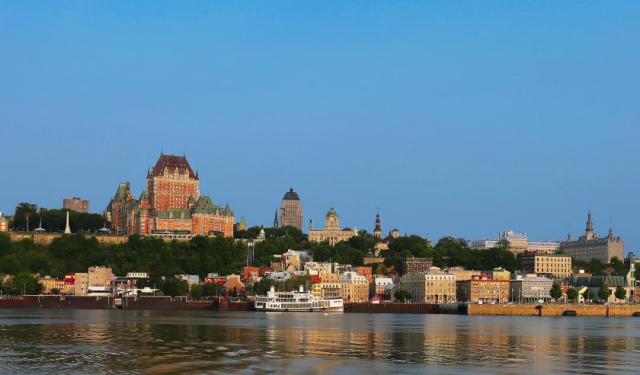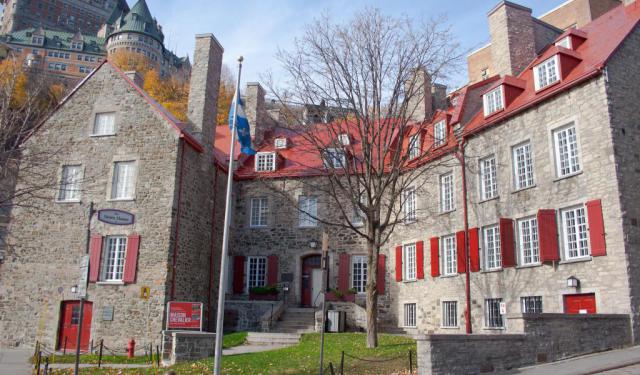
Chateau Frontenac, Quebec City
One of the most astonishing buildings in Quebec, renowned for its fortress-like architecture and majestic location – sitting on top of the Cape Diamond (Cap Diamant) ridge, the Frontenac Castle (Château Frontenac) proudly holds the title of the "most photographed hotel in the world".
Opened in 1893, this was one of the first grand railway hotels built by the Canadian Pacific Railway in the country, whose 18-floor grandness, augmented by the 54-meter (177-foot) elevation that it sits at, rivaled any European hotel of the day and grabbed the attention of travelers visiting the city.
The Châteauesque style of the building was later replicated in other grand railway hotels erected throughout Canada from the late 19th to the early 20th centuries. American architect Bruce Price drew inspiration from Medieval, Renaissance, and Victorian architecture, incorporating into his design such elements as turrets from Scottish castles and bastion towers of French châteaus. The hotel was designated a National Historic Site of Canada in 1981 and expanded on three occasions, most recently in 1993.
The building is named after Louis de Buade de Frontenac, who served twice as the Governor General of New France, and it sits on the site previously occupied by Saint Louis Castle (Château Saint-Louis). The remains of this former seat of the French and later of the British governors of the territory now lie in front of the hotel as an archaeological site.
Over the years, the Frontenac Castle has welcomed many guests of honour among whom were the likes of Queen Elizabeth II, Charles Lindbergh, and other dignitaries and celebrities. Alfred Hitchcock used the building as the setting for his 1953 drama "I Confess", however, the most memorable historic events associated with the hotel are the two Quebec Conferences, held in 1943 and 1944, during which U.S. President Franklin D. Roosevelt, British Prime Minister Winston Churchill, and Canadian Prime Minister William Lyon Mackenzie King discussed Allied strategy for WWII including plans for the invasion of Normandy.
Tip:
If you ever book a room here, ask for a high floor – the 18th floor offers a particularly stunning city view!
Consider taking a hotel tour, offered every day, as there are some good anecdotes and stories to hear from the hotel's history.
Opened in 1893, this was one of the first grand railway hotels built by the Canadian Pacific Railway in the country, whose 18-floor grandness, augmented by the 54-meter (177-foot) elevation that it sits at, rivaled any European hotel of the day and grabbed the attention of travelers visiting the city.
The Châteauesque style of the building was later replicated in other grand railway hotels erected throughout Canada from the late 19th to the early 20th centuries. American architect Bruce Price drew inspiration from Medieval, Renaissance, and Victorian architecture, incorporating into his design such elements as turrets from Scottish castles and bastion towers of French châteaus. The hotel was designated a National Historic Site of Canada in 1981 and expanded on three occasions, most recently in 1993.
The building is named after Louis de Buade de Frontenac, who served twice as the Governor General of New France, and it sits on the site previously occupied by Saint Louis Castle (Château Saint-Louis). The remains of this former seat of the French and later of the British governors of the territory now lie in front of the hotel as an archaeological site.
Over the years, the Frontenac Castle has welcomed many guests of honour among whom were the likes of Queen Elizabeth II, Charles Lindbergh, and other dignitaries and celebrities. Alfred Hitchcock used the building as the setting for his 1953 drama "I Confess", however, the most memorable historic events associated with the hotel are the two Quebec Conferences, held in 1943 and 1944, during which U.S. President Franklin D. Roosevelt, British Prime Minister Winston Churchill, and Canadian Prime Minister William Lyon Mackenzie King discussed Allied strategy for WWII including plans for the invasion of Normandy.
Tip:
If you ever book a room here, ask for a high floor – the 18th floor offers a particularly stunning city view!
Consider taking a hotel tour, offered every day, as there are some good anecdotes and stories to hear from the hotel's history.
Want to visit this sight? Check out these Self-Guided Walking Tours in Quebec City. Alternatively, you can download the mobile app "GPSmyCity: Walks in 1K+ Cities" from Apple App Store or Google Play Store. The app turns your mobile device to a personal tour guide and it works offline, so no data plan is needed when traveling abroad.
Chateau Frontenac on Map
Sight Name: Chateau Frontenac
Sight Location: Quebec City, Canada (See walking tours in Quebec City)
Sight Type: Attraction/Landmark
Guide(s) Containing This Sight:
Sight Location: Quebec City, Canada (See walking tours in Quebec City)
Sight Type: Attraction/Landmark
Guide(s) Containing This Sight:
Walking Tours in Quebec City, Quebec
Create Your Own Walk in Quebec City
Creating your own self-guided walk in Quebec City is easy and fun. Choose the city attractions that you want to see and a walk route map will be created just for you. You can even set your hotel as the start point of the walk.
Qucbec City's Historical Churches Walking Tour
The first religious buildings in Canada were established by the Récollets and Jesuits, in 1615 and 1625, respectively, when they first arrived in New France. Later on, the French colonists brought along their culture and architectural traditions, and the establishment of British and evangelical society triggered further major developments in Quebec City.
Over the course of the 17th and 18th... view more
Tour Duration: 2 Hour(s)
Travel Distance: 2.9 Km or 1.8 Miles
Over the course of the 17th and 18th... view more
Tour Duration: 2 Hour(s)
Travel Distance: 2.9 Km or 1.8 Miles
Old Quebec Walk
The historic part of Quebec City known as Old Quebec (French: Vieux-Québec), sometimes also referred to as the Latin Quarter (Quartier Latin), is the neighborhood centered around Cape Diamond (Cap Diamant), located on the eastern edge of Quebec hill promontory. The area comprises Upper Town (Haute-Ville) and Lower Town (Basse-Ville) and is currently listed among UNESCO’s World Heritage Sites.
... view more
Tour Duration: 2 Hour(s)
Travel Distance: 2.6 Km or 1.6 Miles
... view more
Tour Duration: 2 Hour(s)
Travel Distance: 2.6 Km or 1.6 Miles
Quebec City Introduction Walking Tour
Cresting a cliff above the St. Lawrence River, Québec City (French: Ville de Québec) is the soul of the province of Québec – a place all its own; a country within a country with its own traditions, architecture, and French-speaking population.
The Algonquian people had originally named the area Kébec, which means "where the river narrows", because the Saint Lawrence River... view more
Tour Duration: 2 Hour(s)
Travel Distance: 3.2 Km or 2 Miles
The Algonquian people had originally named the area Kébec, which means "where the river narrows", because the Saint Lawrence River... view more
Tour Duration: 2 Hour(s)
Travel Distance: 3.2 Km or 2 Miles
Historical Houses Walking Tour
Quebec City, particularly evocative of Europe in its atmosphere, is often referred to as the cradle of New France. The city boasts one of the richest architectural heritages in North America, though most of its buildings had to be adapted to harsh winters and the lack of specialized workers and materials in the colony. As such, the majority of local houses were designed as simple and efficient... view more
Tour Duration: 2 Hour(s)
Travel Distance: 2.5 Km or 1.6 Miles
Tour Duration: 2 Hour(s)
Travel Distance: 2.5 Km or 1.6 Miles




